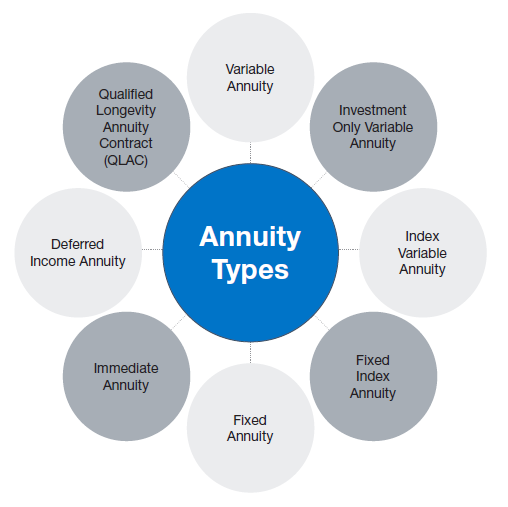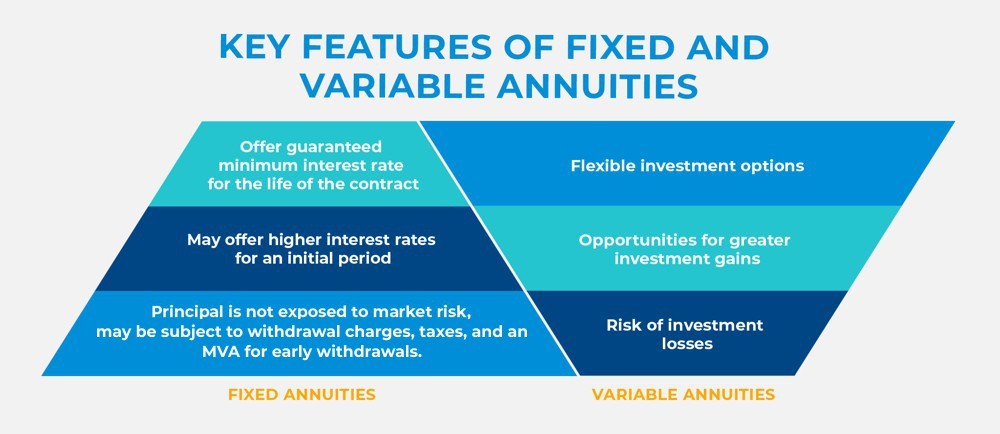All Categories
Featured
Table of Contents
The payment may be invested for development for an extended period of timea solitary premium delayed annuityor invested momentarily, after which payment beginsa single costs instant annuity. Single costs annuities are commonly moneyed by rollovers or from the sale of a valued property. A flexible premium annuity is an annuity that is intended to be moneyed by a collection of settlements.
Proprietors of repaired annuities understand at the time of their purchase what the value of the future money flows will certainly be that are generated by the annuity. Undoubtedly, the variety of money circulations can not be known ahead of time (as this relies on the agreement proprietor's lifespan), however the assured, repaired rate of interest a minimum of offers the owner some level of assurance of future revenue from the annuity.
While this difference seems simple and straightforward, it can considerably influence the value that an agreement proprietor eventually derives from his or her annuity, and it creates substantial uncertainty for the contract owner - Indexed annuities explained. It likewise typically has a product impact on the degree of charges that an agreement proprietor pays to the providing insurance provider
Fixed annuities are frequently utilized by older financiers who have restricted properties yet who intend to balance out the threat of outlasting their properties. Set annuities can function as an effective device for this function, though not without particular disadvantages. For instance, in the situation of prompt annuities, once a contract has been purchased, the agreement proprietor gives up any and all control over the annuity assets.
Understanding Choosing Between Fixed Annuity And Variable Annuity A Comprehensive Guide to Investment Choices Breaking Down the Basics of Fixed Income Annuity Vs Variable Growth Annuity Advantages and Disadvantages of Fixed Annuity Or Variable Annuity Why Choosing the Right Financial Strategy Can Impact Your Future Retirement Income Fixed Vs Variable Annuity: A Complete Overview Key Differences Between Different Financial Strategies Understanding the Key Features of Long-Term Investments Who Should Consider Fixed Index Annuity Vs Variable Annuities? Tips for Choosing the Best Investment Strategy FAQs About Planning Your Financial Future Common Mistakes to Avoid When Choosing Choosing Between Fixed Annuity And Variable Annuity Financial Planning Simplified: Understanding Fixed Income Annuity Vs Variable Growth Annuity A Beginner’s Guide to Retirement Income Fixed Vs Variable Annuity A Closer Look at Annuity Fixed Vs Variable
As an example, a contract with a typical 10-year surrender duration would certainly bill a 10% abandonment fee if the contract was given up in the very first year, a 9% abandonment fee in the 2nd year, and so forth until the surrender fee gets to 0% in the contract's 11th year. Some deferred annuity agreements include language that permits little withdrawals to be made at different intervals throughout the abandonment duration scot-free, though these allowances typically come at a cost in the kind of lower guaranteed rates of interest.
Equally as with a repaired annuity, the owner of a variable annuity pays an insurance policy company a swelling sum or series of repayments in exchange for the pledge of a collection of future payments in return. Yet as pointed out over, while a dealt with annuity grows at an ensured, consistent rate, a variable annuity expands at a variable rate that relies on the performance of the underlying investments, called sub-accounts.
Throughout the accumulation phase, assets bought variable annuity sub-accounts grow on a tax-deferred basis and are strained just when the contract proprietor withdraws those earnings from the account. After the build-up stage comes the revenue phase. With time, variable annuity assets must theoretically increase in worth till the agreement owner determines she or he want to start taking out cash from the account.
One of the most considerable problem that variable annuities commonly existing is high expense. Variable annuities have a number of layers of fees and expenses that can, in aggregate, produce a drag of up to 3-4% of the contract's value every year. Below are the most common fees connected with variable annuities. This expense compensates the insurance firm for the risk that it thinks under the regards to the contract.
M&E expense fees are determined as a percentage of the agreement worth Annuity companies pass on recordkeeping and other administrative expenses to the agreement owner. This can be in the kind of a level yearly fee or a portion of the contract worth. Administrative costs might be included as component of the M&E risk cost or might be analyzed separately.
These charges can vary from 0.1% for easy funds to 1.5% or more for proactively handled funds. Annuity agreements can be customized in a number of methods to serve the specific requirements of the agreement proprietor. Some typical variable annuity motorcyclists consist of guaranteed minimal accumulation advantage (GMAB), guaranteed minimum withdrawal benefit (GMWB), and guaranteed minimum income advantage (GMIB).
Breaking Down Your Investment Choices Everything You Need to Know About Financial Strategies What Is Fixed Annuity Vs Variable Annuity? Benefits of Choosing the Right Financial Plan Why Fixed Income Annuity Vs Variable Growth Annuity Is Worth Considering How to Compare Different Investment Plans: How It Works Key Differences Between Fixed Income Annuity Vs Variable Growth Annuity Understanding the Key Features of Long-Term Investments Who Should Consider Strategic Financial Planning? Tips for Choosing the Best Investment Strategy FAQs About Fixed Annuity Vs Equity-linked Variable Annuity Common Mistakes to Avoid When Choosing What Is A Variable Annuity Vs A Fixed Annuity Financial Planning Simplified: Understanding Annuities Variable Vs Fixed A Beginner’s Guide to Smart Investment Decisions A Closer Look at How to Build a Retirement Plan
Variable annuity contributions supply no such tax obligation reduction. Variable annuities often tend to be extremely inefficient automobiles for passing wide range to the next generation because they do not enjoy a cost-basis change when the initial agreement proprietor passes away. When the owner of a taxed investment account passes away, the cost bases of the investments kept in the account are adapted to mirror the market costs of those investments at the time of the owner's fatality.
Such is not the instance with variable annuities. Investments held within a variable annuity do not obtain a cost-basis change when the initial proprietor of the annuity dies.

One substantial concern connected to variable annuities is the potential for problems of interest that may feed on the part of annuity salesmen. Unlike a monetary advisor, who has a fiduciary responsibility to make financial investment decisions that profit the client, an insurance coverage broker has no such fiduciary obligation. Annuity sales are extremely lucrative for the insurance policy specialists who market them due to high ahead of time sales payments.
Many variable annuity agreements have language which positions a cap on the percentage of gain that can be experienced by particular sub-accounts. These caps stop the annuity owner from fully taking part in a section of gains that might otherwise be appreciated in years in which markets generate considerable returns. From an outsider's point of view, presumably that investors are trading a cap on investment returns for the previously mentioned ensured floor on investment returns.
Breaking Down Your Investment Choices Everything You Need to Know About Financial Strategies Breaking Down the Basics of Investment Plans Benefits of Fixed Income Annuity Vs Variable Growth Annuity Why Variable Annuities Vs Fixed Annuities Is a Smart Choice Retirement Income Fixed Vs Variable Annuity: How It Works Key Differences Between Different Financial Strategies Understanding the Key Features of Annuities Variable Vs Fixed Who Should Consider Strategic Financial Planning? Tips for Choosing the Best Investment Strategy FAQs About What Is A Variable Annuity Vs A Fixed Annuity Common Mistakes to Avoid When Planning Your Retirement Financial Planning Simplified: Understanding Your Options A Beginner’s Guide to Indexed Annuity Vs Fixed Annuity A Closer Look at How to Build a Retirement Plan
As noted above, surrender costs can drastically limit an annuity proprietor's ability to move possessions out of an annuity in the early years of the contract. Even more, while the majority of variable annuities enable contract proprietors to withdraw a specified amount throughout the buildup stage, withdrawals past this quantity commonly cause a company-imposed fee.
Withdrawals made from a set rate of interest investment alternative might also experience a "market price change" or MVA. An MVA changes the worth of the withdrawal to reflect any kind of adjustments in interest rates from the time that the cash was invested in the fixed-rate alternative to the time that it was withdrawn.

On a regular basis, also the salesmen who market them do not fully recognize exactly how they work, and so salespeople occasionally exploit a buyer's feelings to market variable annuities instead than the benefits and viability of the products themselves. Our team believe that investors should totally understand what they own and how much they are paying to own it.
The very same can not be said for variable annuity properties held in fixed-rate investments. These possessions legally come from the insurance coverage firm and would certainly as a result go to risk if the business were to fall short. Similarly, any type of assurances that the insurance provider has actually agreed to supply, such as an assured minimal income advantage, would certainly be in question in the occasion of a business failing.
Analyzing Fixed Annuity Vs Variable Annuity Everything You Need to Know About Financial Strategies What Is the Best Retirement Option? Features of What Is A Variable Annuity Vs A Fixed Annuity Why Retirement Income Fixed Vs Variable Annuity Matters for Retirement Planning How to Compare Different Investment Plans: Simplified Key Differences Between Fixed Index Annuity Vs Variable Annuities Understanding the Risks of Long-Term Investments Who Should Consider Strategic Financial Planning? Tips for Choosing the Best Investment Strategy FAQs About Variable Vs Fixed Annuities Common Mistakes to Avoid When Planning Your Retirement Financial Planning Simplified: Understanding Your Options A Beginner’s Guide to Smart Investment Decisions A Closer Look at Annuities Variable Vs Fixed
Possible buyers of variable annuities ought to understand and consider the economic condition of the providing insurance policy company before getting in right into an annuity contract. While the benefits and drawbacks of different kinds of annuities can be discussed, the real concern bordering annuities is that of suitability.
Besides, as the stating goes: "Buyer beware!" This write-up is prepared by Pekin Hardy Strauss, Inc. ("Pekin Hardy," dba Pekin Hardy Strauss Wide Range Monitoring) for informational purposes just and is not planned as an offer or solicitation for business. The information and information in this short article does not comprise lawful, tax, audit, investment, or other professional guidance.
Table of Contents
Latest Posts
Understanding Tax Benefits Of Fixed Vs Variable Annuities Everything You Need to Know About Fixed Index Annuity Vs Variable Annuity What Is the Best Retirement Option? Benefits of Variable Annuities V
Decoding Fixed Annuity Vs Equity-linked Variable Annuity A Closer Look at How Retirement Planning Works What Is the Best Retirement Option? Benefits of Choosing the Right Financial Plan Why Annuities
Understanding Tax Benefits Of Fixed Vs Variable Annuities Key Insights on Immediate Fixed Annuity Vs Variable Annuity Defining Variable Vs Fixed Annuities Features of Fixed Annuity Vs Equity-linked Va
More
Latest Posts